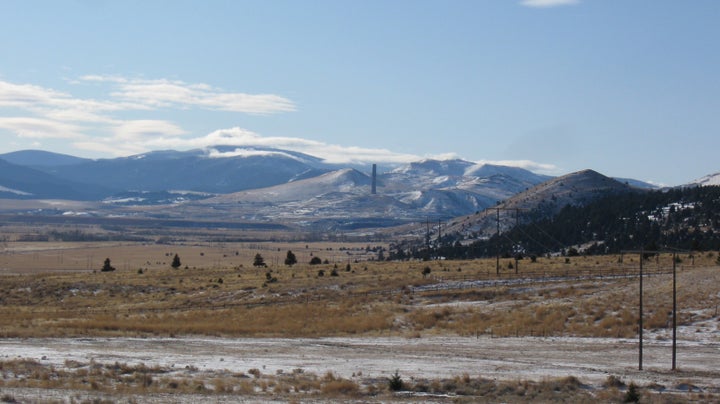
Melissa Nootz and her family once lived in a Montana county containing a Superfund site. Now a Livingston, Montana resident, she reflects on the experience.
Priced out of the first Montana town we loved, my husband and I look for affordable homes without leaving the state. Serendipity offers us an opportunity for a job and very affordable home in the former smelting town of Anaconda. Before committing, I research everything I can find about the risks of living near this Superfund site. The Environmental Protection Agency, the Department of Environmental Quality and independent labs, I call whomever will talk to me about the real risks of living in a town with toxic heavy metals, arsenic, cadmium, copper, lead and zinc. Permeating the soil and waters across town, their reach extends far beyond. And then I call them again. Pages of scrawled notes sprawl across my counters. I guess it’s simple: If we buy a house and the levels of toxic heavy metals in the soil are high, our yard will be remediated. Late nights staring at the ceiling from bed, I wonder which path is for us, feeling torn somewhere between my head and my heart.
My husband and I take a second set of vows nine years after our first vows. We promise each other to obey all the recommendations gathered from all the guiding agencies to the letter: scrubbing windowsills, shoes off upon entry, wash hands before every meal, wash hands after playing outside, never eat food dropped on the ground, keep the sod intact, remediate soils before gardening and on and on. It’s not so bad. I can do this.
We finally find it, our first home ― kitchen overlooking the yard, wood floors, a bright sunroom, nice neighbors, close to his work, a space for the sewing machine, a garage, and it even comes with a 1950s dining room table that I love. We move to a new house in a new town. It’s all really good, and I’m really happy.
Our yard’s soil is tested. There are so many organizations involved. It’s confusing. I’m not always sure where to go for what answers. The results are in. The numbers are high and are exceeding the limits for arsenic. They dilute the data by using averages, hotspots don’t matter, and now only the boulevard is going to be remediated. Wait. There’s a Record of Decision amendment concerning lead. This is supposed to better for us. More of our yard could be remediated. They tell us there’s no timeline for the ROD amendment. We’re on a list for remediation, near the very top. And we’re told to wait.
It sounded so straightforward: If the levels of heavy metals were high, our yard was supposed to be remediated.
My husband and I talk about the numbers. They’re so high. We can’t put our toddler’s swing set over soil with that much lead and arsenic. The sod will wear thin and toxic dirt will become airborne with every push of her feet against the bare ground. The county has a program that doesn’t cost us money. If we do the labor they will haul the toxic soil away, and bring us clean soil. Clean soil ― an oxymoron, I think. So shovelful by shovelful, we dig. From shovel to wheelbarrow, from wheelbarrow to trailer. The county hauls the toxic soil away and brings us clean soil. From trailer to wheelbarrow, from wheelbarrow to shovel, we are making it a safer home for our family.
It’s exhausting, both mentally and physically. I adjust my thoughts, and I recommit myself again and again to love this place ― my home. I love this house. I really do love this house. I just need to keep remembering that. It’s just that one looming thing I loathe with my whole heart is always in my periphery. It sucks all the spontaneity that’s still inside me.
We want another child, and my husband now insists on digging alone. He wants to keep us safe.
I’m pregnant. We’re all happy. And one afternoon, there it is: the reddest blood I’ve ever seen. I have an ultrasound. There is no heartbeat. I am in labor. This can’t be happening, but it is. Several hours slip away. It’s late. My husband’s hands on my shoulders and words in my face pull me from unconsciousness, and I wake to a fear in his eyes I’ve never seen before. I’ve never fainted before that night. My pregnancy is over.
I wonder if this could be related to living here. My health care providers tell me that sometimes these things happen without a reason.
Summer comes and goes, and he digs. More toxic soil out, new gardens in. Life goes on. And I hold on tightly to what I love: my family, this house, growing plants in gardens.
I’m pregnant again. We’re all hopeful. We hear a heartbeat. Weeks pass, and the heartbeat is gone. I have an ultrasound. The image of our lifeless baby is on the screen. This can’t be happening, but it is. Ready, I awaken to a strange and familiar sensation from within me. The house is still and dark. I am in labor. I call my doula. There is a heavy spring snow falling. Several hours slip away. It’s dawn. Between contractions I watch the snow capped leaves outside the window bending toward the earth. The snow keeps falling. I wonder if the branches can hold the weight. My pregnancy is over.
I wonder again if this could be related to living here. My health care providers tell me that sometimes these things happen without a reason. They pause, adding that testing for causes typically doesn’t begin until after three consecutive losses.
Summer comes and goes, and my husband digs. More toxic soil out, new gardens in. Life goes on. And I hold on tightly to what I love: my family, this house, growing plants in gardens.
I’m pregnant again. We worry. We hear a heartbeat. We worry more. We see her on the ultrasound, and she is very much alive. We worry more than we ever have worried. It’s Christmas Eve. This can’t be happening, but it is. I am in labor. I call my doula and midwife. Several hours later and my pregnancy is over. She is born at home on Christmas morning.
“When my daughter is 1, a routine test shows she has lead in her blood.”
When she is 1, a routine test shows she has lead in her blood. My husband and I faithfully kept our vows, and we feel cheated and betrayed and utterly, helplessly devastated.
I wonder how many times I can shatter into a million pieces, sweep myself up, and pull myself back together.
It sounded so straightforward: If we followed the recommended protocols, we were supposed to be safe. We were near the top of the priority list. Our yard was supposed to be remediated.
On my birthday, we move into a new home in a new town: Livingston. I love both of these things for a host of reasons related and unrelated to our experiences in our previous home. We no longer live near a Superfund site. I’m not fragile. And I never broke. I am simply a mother, just like the many mothers before me and beside me.
To satiate my long-held curiosity, I search to learn if heavy metal exposure could be linked to miscarriage and infant loss. The short answer is yes, they can be linked. I’m mostly numb to these facts.
Now that we moved away, people tend to ask a lot of questions trying to understand what it’s like to live near a Superfund site. Mothering in a frontline community with toxic pollution silently threatening to poison us all, in most ways I suppose, is just like mothering anywhere. But then, I don’t really know any other way to mother.
I wonder if I’ll ever feel spontaneous and lighthearted again. And I hold on tightly to what I love: my family, this house, growing plants in gardens. It’s so not bad. I can do this.
